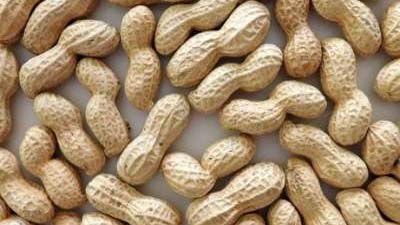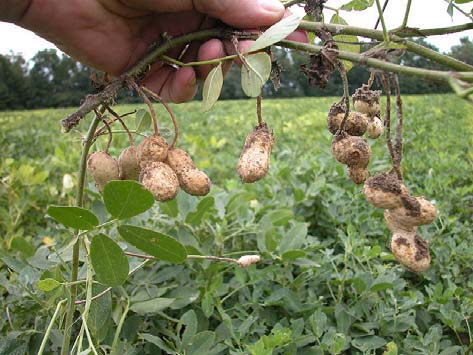Peanuts in the Garden

Summary
- Peanuts are not commonly grown in Utah, but certain types can be productive when the frost- free growing season is more than 110 days.
- Peanuts grow best in light, sandy soil, but can be grown in most other soil types if compost is incorporated to sufficiently loosen the soil.
- Peanuts pods (nuts) grow underground. After the flowers are pollinated, a structure called a peg, extends into the soil where peanuts grow.
- Peanuts are harvested when leaves start to yellow at the end of the growing season.
- When seeds are treated before planting with rhizobium bacteria, peanut plants add nitrogen to the soil like peas and beans. After peanuts are harvested in the autumn, the remaining plant material should be incorporated back into the soil or composted.
Introduction
Peanuts are native to South America, have been used as a food crop for thousands of years and are popular worldwide. A unique feature of peanuts is that pods containing seeds (nuts) mature underground. Once flowers are fertilized, a structure called a peg that forms the pod extends underneath the soil surface. If the peg does not penetrate the soil or get covered, the pods will not develop and produce seeds. Peanuts are very nutritious as they are rich in protein, unsaturated fat and many vitamins and minerals.
Peanut Varieties
| Variety | Days to Maturity | Seed Characteristics and Comments |
|---|---|---|
| Valencia | 120-130 | Produces three small nuts per pod, and has a sweeter flavor than other varieties. Best for areas with fewer frost free days. Little breeding has occured for disease resistance, but Valencia types are still fine for use by the home gardener practicing sound garden management practices. |
| Early Spanish | 90-130 | Produces two to three small nuts per pod. Has great oil content than other varieties. Commonly used for peanut butter and in candy bars. |
| Early or Jumbo Virginia | 120-130 | Produces one to two large nuts per pod. Virginia peanuts are commonly roasted in the shell; sold as shelled, salted/flavored nutes; used in cooking and processed foods due to large nut size. |
| Runner Types | 125-165 | Runner type uses are similar to Virginia varieties. Some earlier ripening varieties exist, including 'AT 215'. Sometimes referred to as beer nuts. |
How to Grow
Soils
Peanuts prefer light, humus rich, and sandy soil. Most soils are suitable for production when amended with enough organic matter to allow for good root growth, peg penetration and pod development. A soil analysis reveals potential soil problems and can be useful for those beginning a garden.
Soil Prep
Before planting, determine fertilizer needs with a soil test and then follow the recommendations given with the test report. For more information on how to test soil, visit the USU Analytical lab. If fertilizer applications are warranted, work the fertilizer into the top 6 inches of soil. If you fertilize with compost, apply no more than 1 inch of well-composted organic matter per 100 square feet of garden area.
Plants
Peanuts are grown from seed and not transplants. Seeds can be purchased online, via mail order or possibly from a local vendor. One pound of seeds will seed a 75 foot row.
Planting and Spacing
Seeds can be left in the shell (hull) or removed. When removed, seeds germinate more quickly, but if the thin, red seed coat is cracked or damaged, the seed is most likely dead. Sow seeds 1½ inches deep, 18 inches apart, with 4 seeds per mound when soil temperatures are above 65° F (usually around the last frost). Rows should be spaced every 24 inches.
It is possible to obtain greater yields by using season extending gardening techniques. These include use of hoop houses, cold frames and/or floating row cover. If plastic mulches are used, it must be removed when plants begin to flower.
As plants grow, hill them up like potatoes. Mound 6 inches of soil around plants when they reach a foot tall. Hills allow room for the underground pods to develop and provide added soil drainage. After hilling, place 3 to 4 inches of compost or grass clippings around and between plants. This will help retain soil moisture, control weeds and keep the soil at an even temperature.
Irrigation
Peanuts require uniform soil moisture levels throughout the year, so apply 1 to 2 inches of water per week. The organic mulch around the plant helps conserve soil moisture. Irrigate so that moisture goes deeply into the soil. Irregular watering (over or under) can cause root rots and will reduce yields
Fertilization
The application of nitrogen fertilizer to peanuts is usually not necessary because they obtain sufficient nitrogen via a beneficial relationship formed with nitrogen fixing rhizobium bacteria. These bacteria, while living in nodules formed on the roots, convert nitrogen from the air into a usable form for the plant. For this to occur, peanuts must be pretreated with an inoculant containing the bacteria prior to being planted. Compatible bacteria may be purchased through mail order or online through garden vendors. Powder inoculants are easier to use compared to liquid forms. When peanuts are not inoculated with bacteria, they benefit from fertilize applications based on the soil test. Apply when they are first planted and again 1 month later.
Problems
Weeds
Use 2 to 3 inches of mulch around plants to control weeds. If weed control is needed after pegs have penetrated the soil, cultivate no more than a few inches deep to protect developing underground seeds.
Insects and Other Pests
Peanuts are usually not impacted by insect pests. Some of the more common pests that may be seen include wire worms, army worms, cut worms, aphids, thrips and corn ear worm. If these problems arise, contact your local Extension office for assistance.
Mice and other ground dwelling animals sometimes feed on developing seeds while still underground. Additionally, harvested, drying nuts may be fed on by various animals. Exclusionary measures may be needed to protect developing and harvested nuts from these animals.
Diseases
Locally, peanuts do not commonly contract many diseases. Maintain proper plant health to minimize risk. If plants exhibit disease symptoms, help identifying the disorder can be at your local Extension office.
Harvesting and Storage

Peanut plants should be dug in the fall when plant leaves begin to yellow or after the first frost. Check the soil from around the pulled plants to ensure all pods have been collected.
Peanuts should be left on the plant and dried for 1 to 2 weeks in a well ventilated area. Then remove pods from the plants and dry for an additional 2 to 3 weeks in a warm area with low humidity (below 60%-70% relative humidity). Total drying time will be about 4 weeks. Discard any diseased or otherwise unhealthy looking nuts and store at 35-40°F and 50- 60% relative humidity.
Once sufficiently dry, nuts can be roasted. Place whole on cookie sheets and cooking in the oven at 350° F. This will loosen the seed coat surrounding the nut.
Roasting time varies from 13 to 18 minutes. Shelled nuts require a shorter amount of time. Roast a few test batches before processing the entire harvest to determine an appropriate roasting time. Store roasted nuts in air-tight containers. At room temperature, nuts should be consumed within 3 to 4 weeks. Refrigerated, roasted nuts can be stored for 6 to 12 months at 40°F. Peanuts can also be stored in air-tight, freezer safe containers for at least a year.
Productivity
Trials in Wisconsin and Canada found that plants produce 4 to 7 lbs. of nuts in pods per 100 square feet.
Nutrition
Peanuts are rich in protein and unsaturated fat which can lower LDL-cholesterol levels. Additionally, they are a good source of vitamin E, niacin, folate, thiamin, magnesium, copper phosphorus, potassium, zinc and iron.
Frequently Asked Questions
How can I increase peanut yields?
Peanuts grow best at temperatures around 85° F. To increase yields, avoid planting in frost pockets and consider using season extending gardening methods.
References
- Smyser, S. 1978. The Encyclopedia of Organic Gardening. Rodale Press. Emmaus Pennsylvania
Lemon, R. 2010. Texas Peanut Production Guide. Texas Agricultural Extension Service. College Station, Texas. (Online at: http://agrilife.org/peanut/files/2012/04/D__peanut_pdfs_productionguide07_3_11.pdf ) - Trostle, C. 2002. Questions and Answers about Rhizobium and Inoculation for Peanuts. Texas Agricultural Extension Service. Lubbock, Texas.
- Putnam, D., E. Oplinger, T. Teynor, E. Oekle, K. Kelling, and J. Doll. 1991. Alternative Field Crops Manual: Peanut. University of Wisconsin Cooperative Extension. Madison, Wisconsin. (Online at: https://hort.purdue.edu/newcrop/afcm/peanut.html )
- Jordan, D. 2010. Peanut Information 2010. Center for IPM.North Carolina State University. Raleigh, North Carolina. (Online at: http://ipm.ncsu.edu/Production_Guides/Peanuts/main.pdf
Utah State University Extension
Peer-reviewed fact sheet
Download PDF
Authors
Taun Beddes and Dan Drost, USU Vegetable Specialists
Related Research








